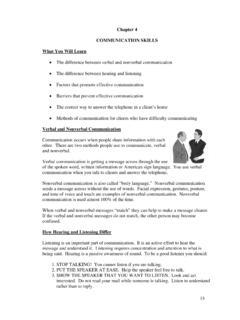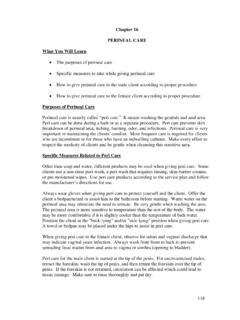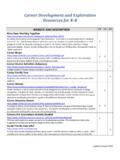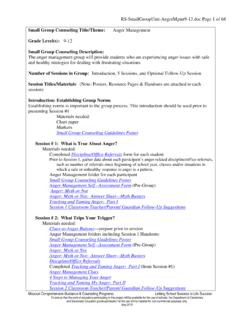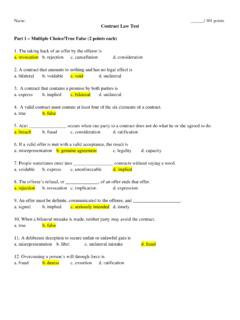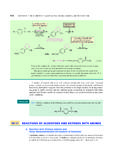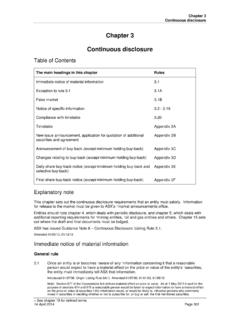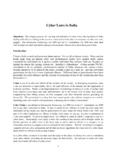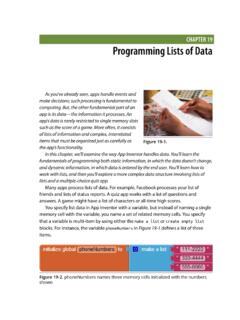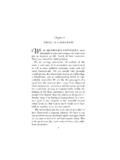Transcription of Chapter 19 TUB BATH AND SHOWER What You …
1 137 Chapter 19 TUB BATH AND SHOWER what You will learn Key points to follow while giving a tub bath Key points to follow while giving a SHOWER Observations to be made during a tub bath or SHOWER How to give a tub bath according to proper procedure How to give a SHOWER according to proper procedure Key Points of Giving a Tub Bath Bathing should be a relaxing pleasurable experience for the client. Let the client choose which type of bath to take if not specified in the service plan. This is an ideal time to observe the client's skin condition and identify problem areas. Tub baths are given to clients who can get out of bed but may not like showers. The tub bath can provide greater relaxation than a bed bath or a SHOWER and helps some clients feel cleaner. When giving a tub bath, pay attention to safety considerations.
2 The tub should be filled with an adequate amount of warm water (105o F) to cleanse the client. Never fill a tub deeper than waist deep. Do not add bath oil to the water because it makes the surface of the tub slippery and can cause falls. Place a bath mat or towel on the floor outside of the tub to prevent the client from slipping on a wet floor when he steps out of the tub. Do not leave the client unattended while in the tub. The client usually stays in the tub for 10-15 minutes. A longer period would allow the water to cool and could result in the client becoming chilled. Keep the bathroom at 75o-80o F and ensure that it is free from drafts. This helps keep the client warm during the bath. Some clients may be able to bathe with assistance. Provide adaptive equipment as indicated in the service plan (see Figures ).
3 Once a towel has been used to dry any area below the waist, it should not be used on any area above the waist. If the client becomes dizzy during a tub bath, drain the water out of the tub, lower the client's head as Figure Wash Mitt much as possible, and cover the client's head with a dry towel. Fainting is caused by the warm water dilating the blood Figure ; Bathing Tools; Long-handled spoon 138 vessel in the skin. When the circulation to the skin increases, circulation to the brain decreases. This can cause the client to become dizzy or to faint. Key Points of a SHOWER Clients with poor mobility or who have difficulty getting in and out of a bathtub may prefer a SHOWER bath. Some clients prefer a SHOWER because they feel cleaner after a SHOWER than a tub bath. Safety is also a concern when giving a SHOWER .
4 If a SHOWER chair is used, check it for sturdiness and adjust the height as needed. Place a bath mat or towel on the floor outside of the SHOWER to prevent the client from slipping on a wet floor when he steps out of the SHOWER . Always stay with the client while he is in the SHOWER . During the SHOWER , keep the client under warm running water to help prevent chilling. Keep the bathroom at 75o-80o F and ensure that it is free from drafts to keep the client warm. When using a handheld SHOWER nozzle, hang it on the handrail or hook if possible. Do not allow it to rest on the bottom of the SHOWER . The floor is always considered dirty. Some clients may be able to bathe with assistance. Provide adaptive equipment as indicated in the service plan (see Figure ). Once a towel has been used to dry any area below the waist, it should not be used on any area above the waist.
5 If the client becomes dizzy during a SHOWER , turn off the water. If the client is standing, have him sit down and lower his head as much as possible. Cover the client with a dry bath towel. Fainting is caused by the warm water dilating the blood vessels in the skin. When the circulation to the skin increases, circulation to the brain decreases. This can cause the client to become dizzy or to faint. Observations During a Tub Bath or SHOWER During the tub bath or SHOWER , you have an opportunity to observe the condition of the client s skin. Look for areas of redness, rashes, open skin or complaints of pain or tenderness. Remember to report your observations to the nurse/ supervisor. 139 Chapter 19 TUB BATH AND SHOWER PROCEDURE FOR A TUB BATH: 1. Gather necessary equipment. 2. See that the bathroom is free from drafts; preferably 75o-80o F.
6 3. Ensure that the bathtub and bath chair (if used) are clean. If needed, clean the tub and chair with a cleaning solution and rinse according to the in-home provider's policy. 4. Place a nonskid mat, towel, or tub chair in the bathtub. 5. Place a bathmat or towel on the floor next to the bathtub. 6. Explain what you are going to do. 7. Wash your hands and put on gloves if needed. 8. Offer toileting. 9. If the client desires to undress in his room, provide privacy and assist the client to undress and put on his robe and slippers. 10. Ambulate or transfer by wheelchair to the bathroom. 11. Fill the bathtub with 105o F water at least half-full and check water temperature on the inner surface of your forearm. 12. Assist the client to remove robe and slippers or undress if he has not already done so.
7 13. Assist client into the tub according to in-home provider's procedure. 14. Assist the client as needed in washing. If client is unable to help, start with eyes then wash face, ears, neck, arms, hands, chest, abdomen, and back. Ask client if he wants soap used on his face. 15. Rinse with warm water. 16. Wash legs, feet, and in between toes. Rinse with warm water and discard the washcloth in a laundry basket. 17. A shampoo may be given at this time. Cover the client's hair with a towel after shampoo is completed. 140 18. Ask or assist the client to turn slightly to one side. Wash peri area from front to back and discard the washcloth in a laundry basket. 19. Assist the client out of the bathtub and cover him with a towel. Place a towel around his hair if it is wet.
8 20. Drain the bathtub. 21. Remove and discard gloves if used. 22. Uncover the client one area at a time and pat dry with a towel. CAUTION: ONCE A TOWEL HAS BEEN USED TO DRY AN AREA BELOW THE WAIST, IT SHOULD NOT BE USED ON AN AREA ABOVE THE WAIST. 23. Apply powder or lotion and deodorant if applicable. 24. Assist the client with dressing. 25. Help the client to the room of his choice and assist with any personal care such as shaving, nail care, and hair care. 26. Make the client comfortable. 27. Return to bathroom, remove soiled articles, and clean the bathtub. 28. Wash your hands. 29. Record observations and report anything unusual to nurse/supervisor. 141 Chapter 19 TUB BATH AND SHOWER PROCEDURE FOR A SHOWER BATH: 1. Gather necessary equipment. 2.
9 See that bathroom is free from drafts, preferably 75o-80o F. 3. If a SHOWER chair is used, ensure that it is clean. If necessary, clean the chair with a cleaning solution and rinse according to the in-home provider's policy. 4. Place a nonskid mat in SHOWER stall if client is standing during SHOWER . 5. Explain what you are going to do. 6. Wash your hands and put on gloves if needed. 7. Offer toileting. 8. If the client desires to undress in his room, provide privacy and assist client to undress and put on his robe and slippers. 9. Ambulate or transfer client by wheelchair to the bathroom. 10. Assist client to remove robe and slippers or undress if he has not already done so; transfer client to SHOWER chair. 11. Turn on the SHOWER and adjust water temperature (95o-105o F).
10 Direct water spray away from client while adjusting. Flow rate should be gentle. Check water temperature on inner surface of your forearm. NOTE: KEEP THE SHOWER SPRAY DIRECTED TOWARD THE CLIENT'S BODY SO HE will STAY WARM DURING THE SHOWER . 12. Assist the client as needed in washing. If he is unable to help, start with the eyes then wash face, ears, neck, arms, hands, chest, abdomen, and back. Ask the client if he wants soap used on his face. 13. Rinse with warm water. 14. Wash legs, feet, and in between toes. Rinse well with warm water; discard washcloth in a laundry basket. 15. A shampoo may be given at this time; cover client's hair with a towel after shampoo is completed. 142 16. Ask or assist client to turn slightly to one side. Wash peri area from front to back and discard the washcloth in a laundry basket.
